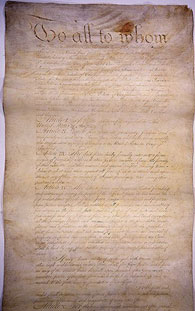
Source: The Articles of Confederation, Wikipedia

Source: The Articles of Confederation, Wikipedia
The Articles of Confederation were written in 1777 shortly after the signing of the Declaration of Independence. Instead of bringing all of the states under the authority of the federal government, the document viewed each state as an independent country agreeing to work together for a common purpose.
The United States declared independence from Great Britain because of the abuse of power from a strong central government. The Articles of Confederation were, perhaps, an overreaction to this fear and created a central government with almost no power.
Structure of the Federal Government
The Articles of Confederation were specifically designed to make it difficult for the new government to pass any laws.
The federal government had just one branch, a Congress. Each state could send a minimum of two and a maximum of seven delegates to the Congress. However, each state received just one vote on any legislation. A supermajority, or nine of the 13 votes, was required to pass legislation. There was no executive branch or judicial branch. The Congress had a president, but he had no power.
→ Quick Reflection: What features of this system would make it difficult to pass laws? Interactive popup. Assistance may be required.
Passing legislation required a supermajority, meaning nine of 13 states. In the 1780s, the states were very different from each other, and few people ever visited even a neighboring state. To travel from Boston to Philadelphia took a minimum of four days. To sail from Boston to Charleston, South Carolina, if the winds were favorable, took a minimum of ten days. Getting nine of these states to agree on anything was almost impossible.
Secondly, before the states could vote, there had to be agreement among the delegates. Sometimes states could not cast a vote at all on an issue because the delegates could not agree on how to cast the state's vote.

Weaknesses of the Articles of Confederation
Even if the Congress could agree on a subject, there became no point to the legislature because it had no authority. Take a look at the following web to see how little power the Congress had. Click on the black boxes to learn more about each power.